You Know You're Having a Bad Day When Your Imaginary Friend Files a Restraining Order Against You
We surveyed 1,000 parents of 3 to 10-year-olds to discover how many imaginary friends exist across the UK today
- 17% of children have an invisible companion, with half-dozen in ten taking a human grade
- 1 in 3 parents thinks an imaginary friend would hurt their kids' social skills, merely parents whose children have pretend pals are half-dozen times less concerned
- 75% of parents feel their child is now more creative thanks to their invisible friend
- Kids aged 1 to 4 who use screens for less than i hour per day are iii.5 times more probable to have an imaginary friend than those with more than two hours screen use per day
Endeavour visualising anybody who lives in Birmingham standing shoulder to shoulder in a heaving oversupply that stretches a kilometre into the distance. Instead of real people, imagine each person is a different fantastical fauna, from mermaids and lions to robots and dragons. This gigantic cast of characters represents every imaginary friend that exists in United kingdom today. In that location are at least one million in full, of all shapes, sizes and species, each ane conjured up by the creative mind of a three to 10 yr-quondam child. Nosotros know this because 17% of ane,000 parents we surveyed said their child currently has a fictional playmate.
We discovered what the nation's imaginary friends wait similar, how they differ between children and whether technology is threatening their existence.
When do children first create imaginary friends?
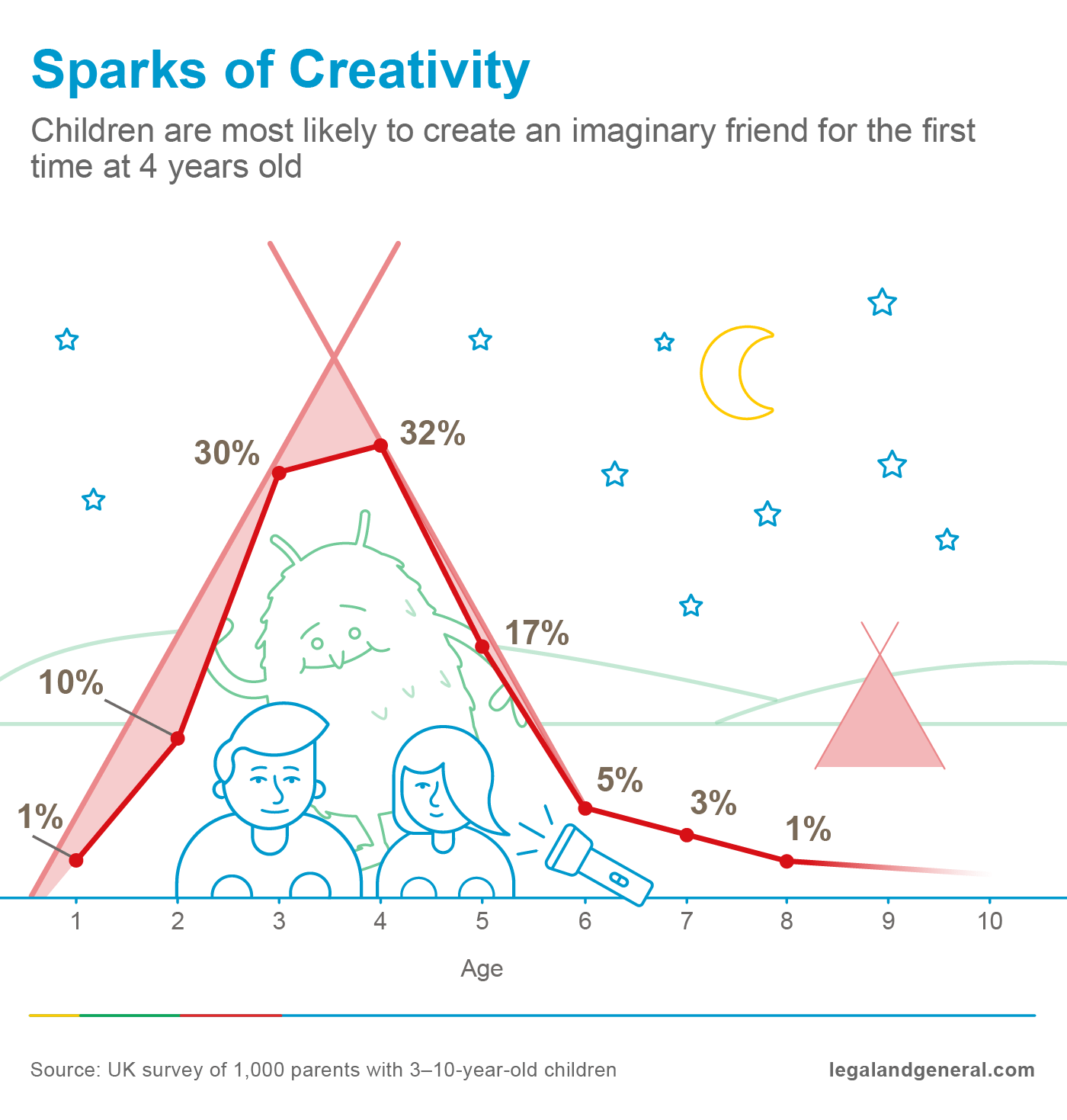
Our survey included ane,000 parents of 3 to 10-year-olds. Imaginary companions aren't restricted to this age range, but our results show that 99% appear by the time the child is 10-years-sometime. The well-nigh mutual age a child dreams up an imaginary companion is four. It's at the iv to 5 year-one-time mark that kids develop greater independence, linguistic communication skills and creativity – vital ingredients for the introduction of an imaginary friend.
However, imaginary companions haven't ever been seen as an expression of positive personality traits. Earlier the 1960s, some children were discouraged from having imaginary friends because researchers believed they revealed an disability to carve up fantasy from reality and might even be a sign of mental illness. Since then, scientific thinking has radically inverse. It's at present thought that 'rehearsing' conversations and interactions with imaginary friends can help children better their social skills and aggrandize their creative thinking.
Based on our results they're also commonplace – on average, 17% of 3 to x year-olds currently have an imaginary friend, and past the historic period of x, there's a 37% take chances a child will take had ane.
When we asked parents how they felt about imaginary companions, their concern differed depending on whether their child had ever had a fictional friend. Among parents of children without imaginary friends, 50% said they would exist at least 'slightly concerned' if their child told them they had 1. Among parents of children with imaginary friends, only 21% expressed business concern.
Parents' apprehension might depend on what blazon of invisible friend their kid is encountering equally there is a large divergence betwixt a fluffy little squirrel and a monster under the bed, which could be a sign of anxiety.
Over l,000 imaginary unicorns roam the U.k.
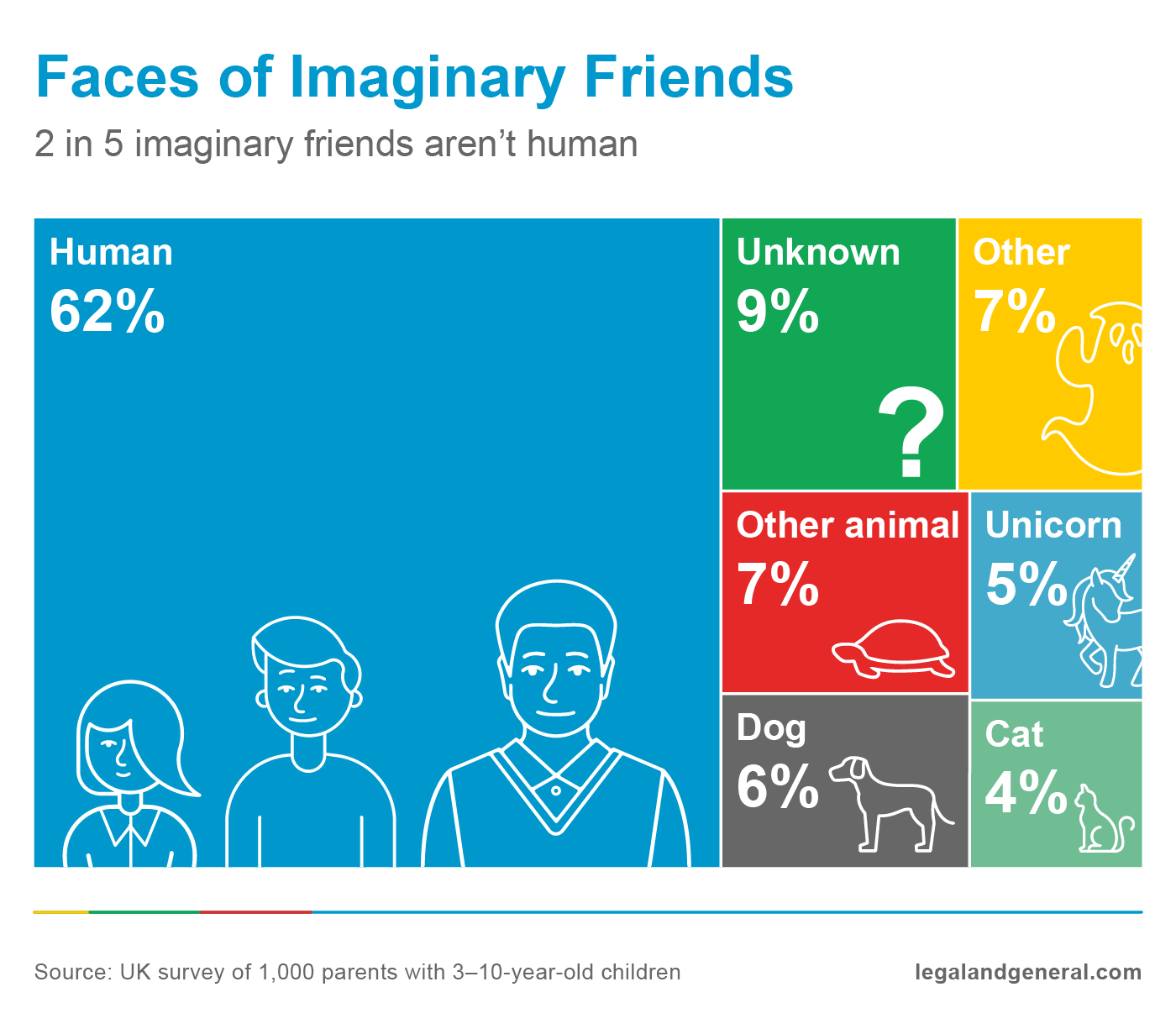
Vi out of 10 imaginary friends are human being, while the balance are a mix of animals and other creatures. Unicorns are more common than cats and only slightly less common than dogs. Girls are 2.5 times more than likely than boys to have an invisible unicorn as a friend (10% vs 4%).
Among the 8% of imaginary companions that weren't people, animals or unknown personalities, there were ninjas, trains, aliens, skeletons, and many miscellaneous monsters. Some parents didn't know what species their child's imaginary friend was. 'Not sure – he lives downwards the plug hole', said 1 mum.
From pocket monsters to invisible behemoths
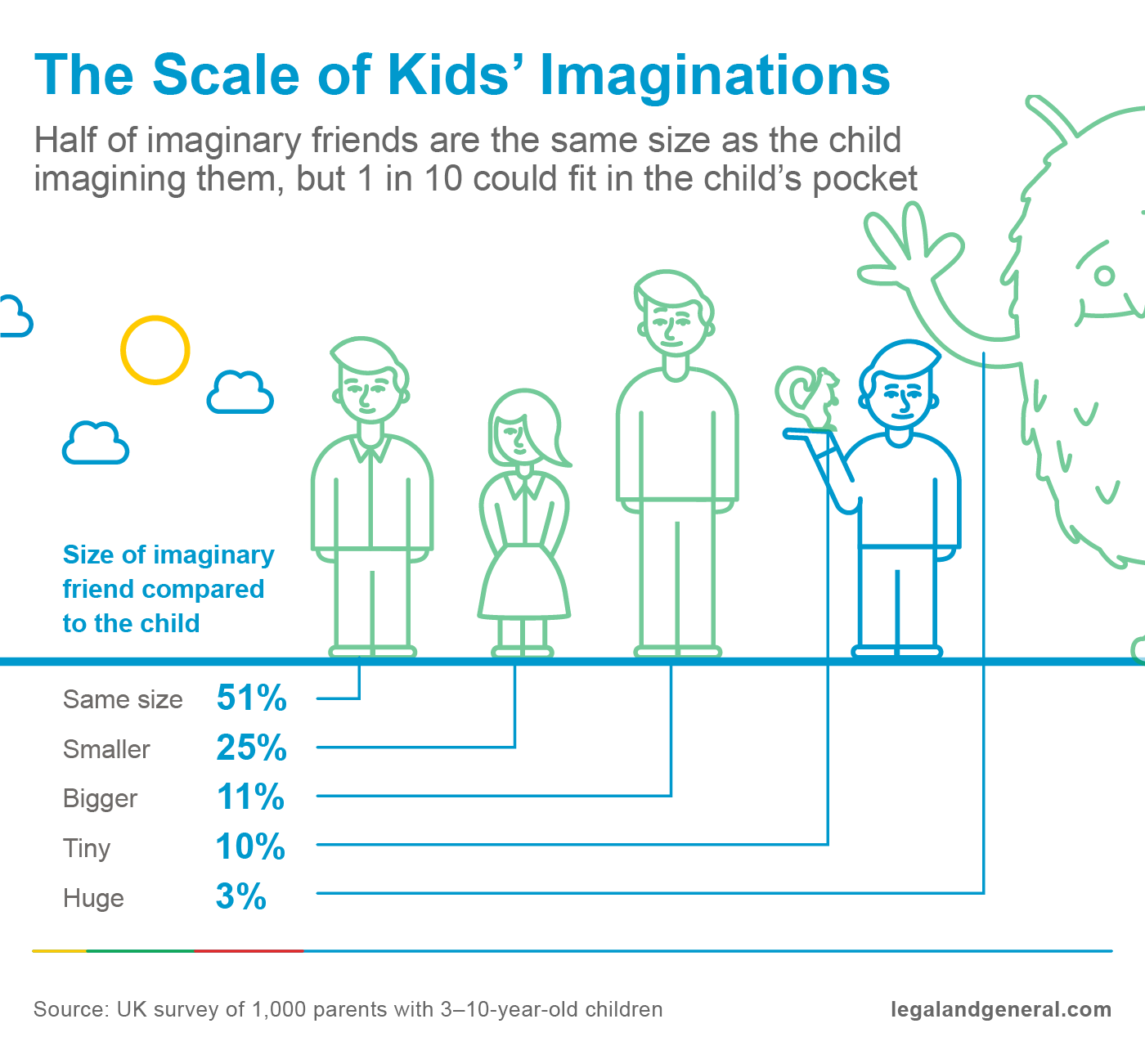
Most imaginary friends are human, and just over half are the same physical size every bit the kid imagining them. This makes sense when we think about the office of imaginary friends every bit playmates and peers to children, walking and talking with them wherever they go.
41% of the parents we surveyed said they were enlightened of their child playing with their imaginary friend at least once per week, and 26% said at least once per mean solar day, which suggests an ongoing friendship like to that of a real kid.
Pretend companions that were smaller than the child imagining them were typically animals like monkeys, rabbits and birds. Larger examples included bears, horses, wolves, dragons, and Beast (from Beauty and Animal). Girls were more than likely than boys to have companions that were smaller than them (34% vs 24%) and they were as well less biased towards the gender of their fictional friend.
Girls are more than likely to imagine friends of the opposite sex
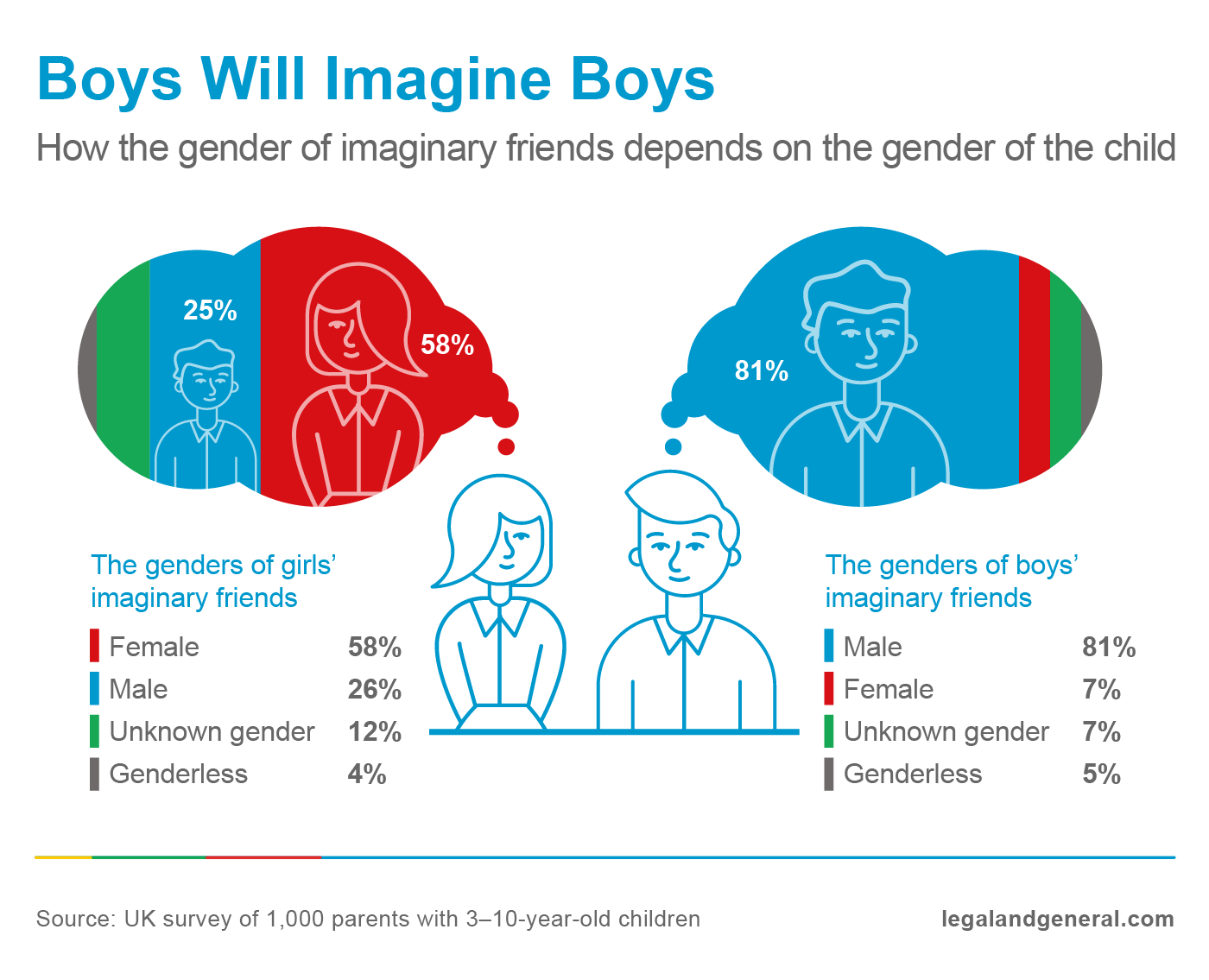
Girls are 3.5 times more probable than boys to take an imaginary friend of the opposite sex. Specifically, 81% of boys' imaginary friends share their gender, compared to 58% of girls'. One possible explanation is that the office of invisible characters in the lives of young girls is slightly dissimilar to boys. For instance, 54% of girls show parenting behaviour towards their invisible character compared to 37% of boys. Examples include checking the friend is wearing their seat belt, helping them safely cross the road, and didactics them how to castor their teeth.
Girls are also slightly more likely to say that their imaginary friend sometimes protects them. 'She told me Catboy watches over her while she sleeps', one dad told us. Several parents said their child's invisible friend wards off other imagined monsters, especially at night and during bad dreams.
On average, one in five parents said their child had blamed something they did on their imaginary friend, with boys being a bit more than likely than girls to pass the buck to their imaginary pal. For example, 'He ate two packs of crisps and claimed his friend had one'. One in twenty parents, equal to around fifty,000 parents nationally, said their child had reported that their imaginary friend had forced them to practice something against their will. 'She drew all over the walls only said she had no option – her friend fabricated her exercise information technology', one parent said.
Peradventure it's imagining such scenarios, in which their children tell tall tales and shift responsibility, that makes some parents recollect imaginary friends are a recipe for antisocial behaviour. Withal, this conventionalities appears to significantly change once a parent has witnessed their child interacting with an imagined playmate.
Imaginary friends don't harm children's social skills
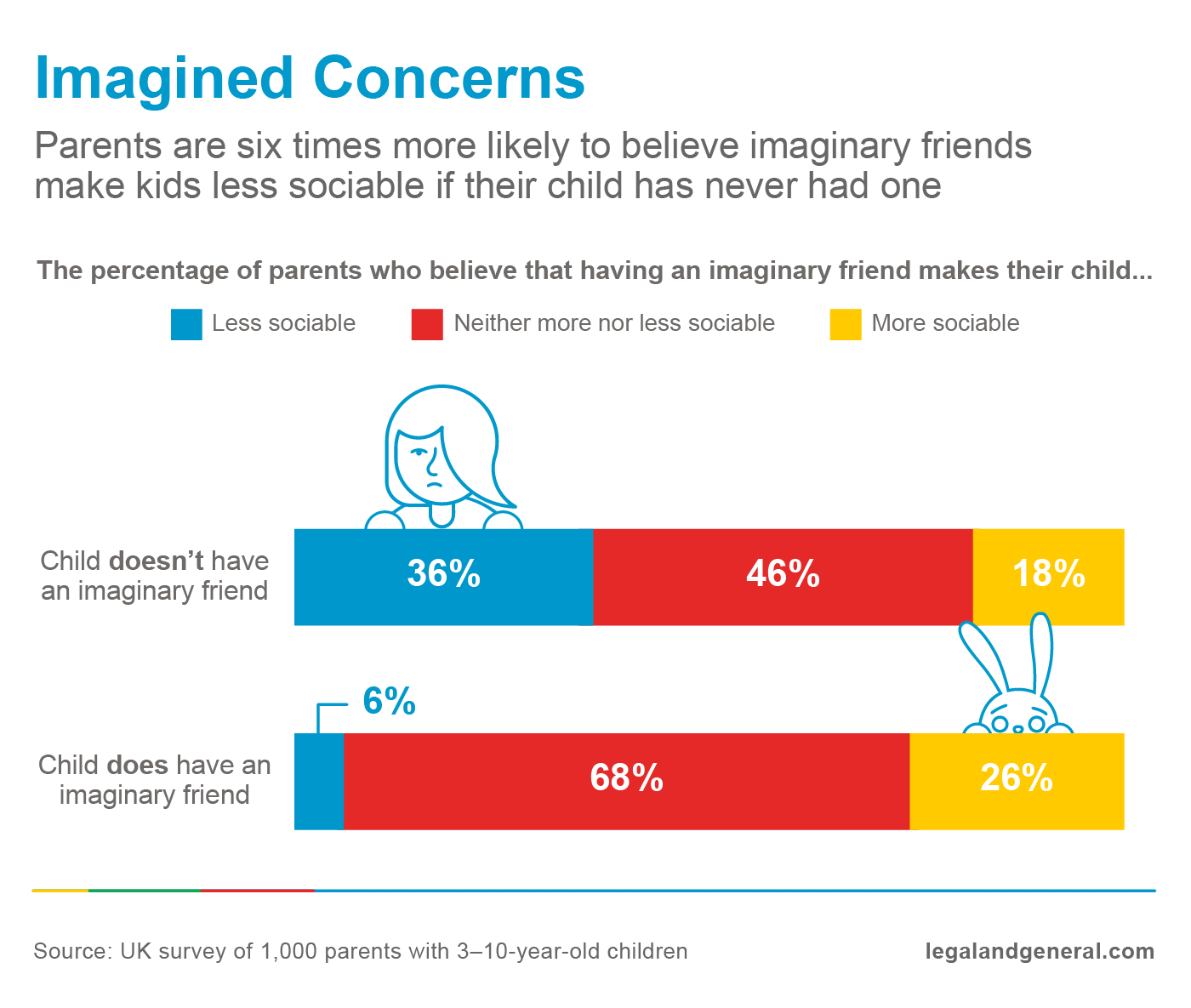
It seems that parents sometimes have overactive imaginations just like their children. One in 3 mums and dads whose kids have yet to have an imaginary friend thinks having one would make their kid less sociable. However, amongst parents who have seen their children interacting with invisible friends, less than one in 10 shared this concern.
One in four parents felt their child was more sociable thanks to their interactions with an imaginary friend, and3 out of four said their kid was more than creative.
Just as adult friendships tin can run their class as circumstances change, kids' relationships with their invisible playmates gradually fade as well. xiv% of imaginary friends are effectually for three to six months, 27% last for 6 months to 1 yr, and 25% survive one to 2 years. But vi%, equivalent to threescore,000 of today'southward fantasy friends, live longer than three years.
Imaginary friends aren't the only invisible characters children believe in. In fact, some of the most widely believed beings aren't the creations of children at all.
Belief in mythical beings starts to drib around historic period six
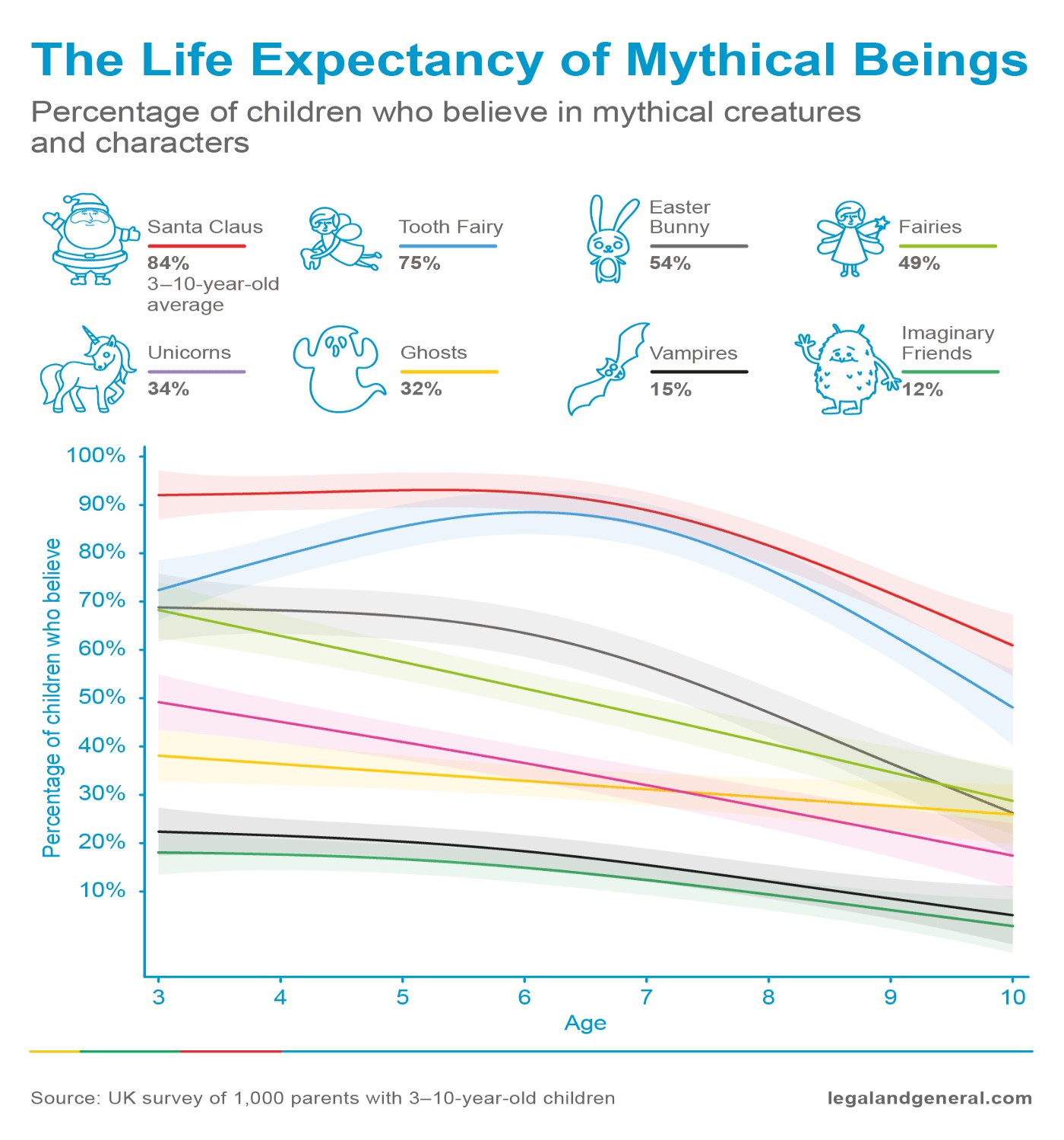
Some mythical characters could be considered 'institutionalised imaginary friends', with hundreds of millions of children (and probably a few grown-ups) firmly believing they be. Santa ranks highest among iii to ten yr-olds, with an average of 84% believing he exists. The level of conventionalities in Santa is but over 90% from the age of 3 to six, then falls each yr afterwards that. At the historic period of 10, belief in Santa has dropped to 61%.
Conventionalities in the Tooth Fairy conveniently rises and falls with the need for a mutual agreement betwixt kid and parent to swap baby teeth for coins nether pillows. Ghosts are a footling different, yet. Of the 7 widespread mythical creatures and characters we polled parents on, the belief in ghosts amid kids was the most consistent, ranging from 38% at the historic period of three to 26% at 10. Interestingly, some parents we spoke to believed their children's imaginary friends were evidence of the afterlife.
'My youngest son used to talk near when he was hither before he was built-in. I think every bit children abound older, many adults tell them there's no such matter every bit an imaginary friend, so the barriers eventually come down and they switch off to being open to spirits'.
Children who believe in various mythical characters are more likely to have imaginary friends. Kids are 46% more likely to recall unicorns are real if they've had an invisible companion, and 28% more than likely to believe fairies exist.
Imaginary friends are oftentimes dreamt up from scratch, whereas Santa, vampires, the Easter Bunny and the Tooth Fairy can all be seen in films, Telly shows and books, which explains why conventionalities in them is more widespread. Just is the use of digital devices to picket shows at any time and in any room or situation stifling kids' imaginations and elbowing out their imaginary friends?
Prolonged screen time can squeeze out imaginary friends
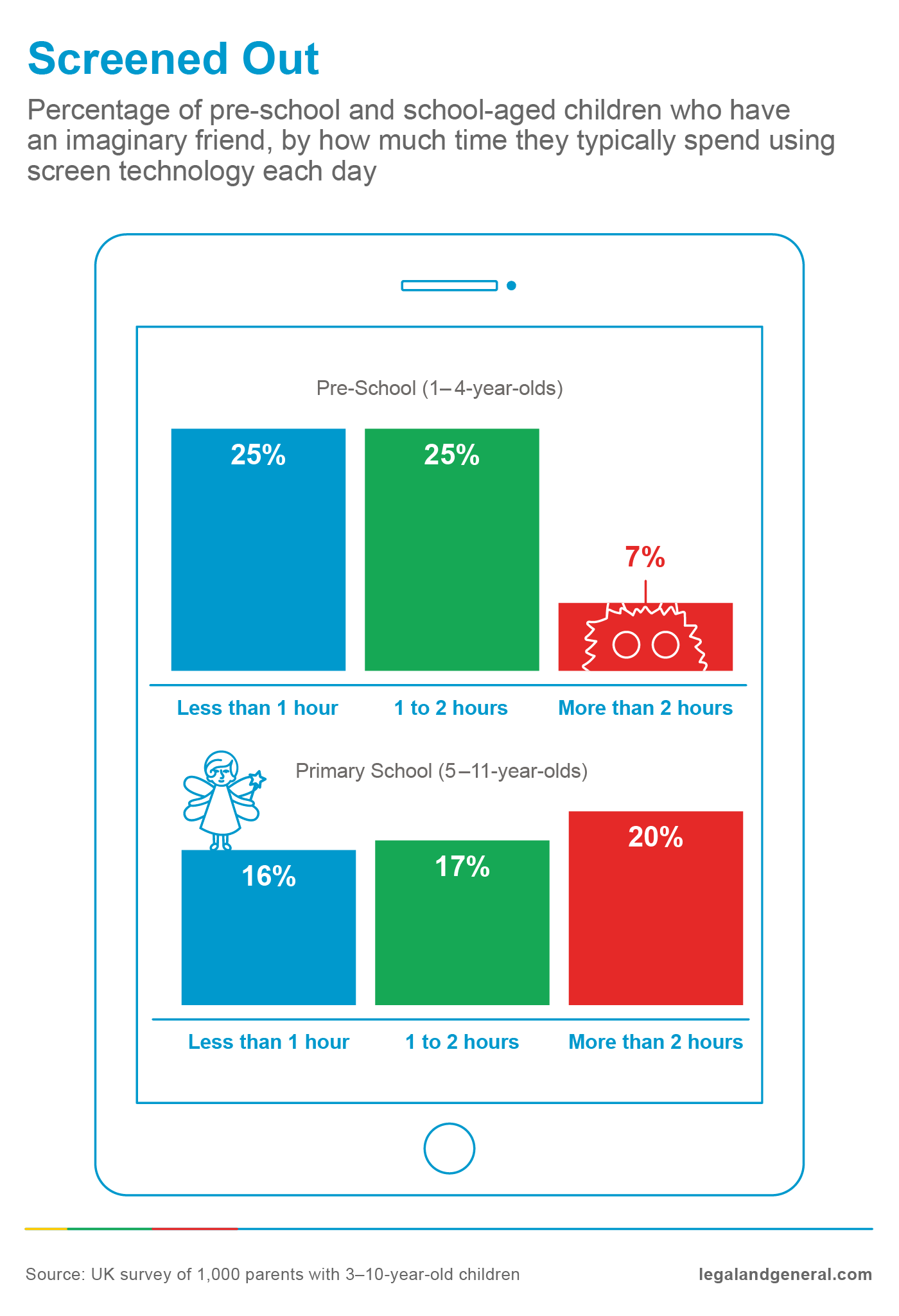
In the past, the presence of an imaginary friend signalled a problem with a child. Today, nosotros're more likely to worry that the absence of an imaginary friend is a sign that a child's creativity and self-directed play haven't developed properly, possibly due to an overreliance on passive forms of entertainment, such as phones, tablets and TV. Our previous research showed that 32% of children have their own phone before they're 9, and 65% accept their own tablet.
Based on our results, there does appear to be a relationship between screen use and the prevalence of imaginary friends, but it'due south not as simple as saying 'Technology is killing imaginary friends'. We only noticed the consequence among very young children. Pre-school children (one to 4 years erstwhile) who use screens for less than two hours a mean solar day were 3.5 times more than likely to take an imaginary friend than those who use screens for more than 2 hours a twenty-four hour period.
As children get older, screen time has less of an consequence on the likelihood that they will have an imaginary friend. Among chief school children (five to 11-years-onetime), sixteen% of children who spent less than an hr a day on screens had an imaginary friend compared to 20% of those who spent more than two hours using a screen. This suggests that technology tin take a negative bear on on the creativity of younger children, but that the outcome lessens equally they become older. This result is backed upwards by previous research showing that children with heavy use of television, video games and computers scored worse than those with light utilize on tests of visual memory, attention span and – the crucial faculty used to dream upward imaginary friends – creative imagination.
Summary
The one one thousand thousand imaginary friends in the UK are a diverse crowd. From humans, to animals and mythical beings of all shapes and sizes, the varied forms imaginary friends take show that imagination in today'due south immature children is alive and well. Parents can feel comforted by the accounts of others who have seen their child grow alongside invisible pals without slowing their social evolution.
However, parents looking to foster creative play in their children should notation that the historic period when imaginary friends are almost arable is when screen engineering is nigh likely to stifle their child'southward inventiveness, past limiting the child's opportunity for unstructured play. The solution is not to cutting technology out altogether – limiting your kid'south screen time to less than two hours a day could help keep a seat complimentary at the kitchen table for their imaginary friend.
Methodology
We surveyed 1,000 British parents with a child anile three to 10 in November 2018. We asked them whether their child has an imaginary friend, to describe the advent and character of that imaginary friend, how their child engages in other forms of imaginative play, and what factors they retrieve make their child more or less likely to have an imaginary friend. Each survey respondent focused on just one child. If they had more than one 3 to 10 yr-old kid, they focused on the child who had the imaginary friend they could describe in most detail.
Off-white use argument
Experience free to share our findings with your friends (real or imaginary) for non-commercial purposes. All we enquire is that you link back to this page to give our enquiry team credit.
Why life without insurance is no fantasy
In that location might be no such thing as the tooth fairy, but the risks of not getting life insurance are all too real. With financial back-up in hard times, y'all tin focus on creating a safe, secure surround where your little ane's imagination can run wild. You won't demand to cover their unicorn, just the greater your protection, the greater your peace of mind. Take a wait at our family unit life insurance guide for more than details.
Sources
https://www.webmd.com/parenting/4-to-5-year-old-milestones#1
https://sites.oxy.edu/clint/physio/article/videoviewingandcognitivedevelopmentinpreadolescents.pdf
http://psychology.tcd.ie/spj/past_issues/issue02/Reviews/%286%29%20David%20Lydon
https://www.ncbi.nlm.nih.gov/pubmed/28707060
https://www.psychologytoday.com/gb/web log/growing-friendships/201301/imaginary-friends
https://world wide web.legalandgeneral.com/life-cover/dislocated-about-life-comprehend/articles-and-guides/screen-time-left-to-their-own-devices
kerferdthised1969.blogspot.com
Source: https://www.legalandgeneral.com/insurance/life-insurance/imaginary-friends/
0 Response to "You Know You're Having a Bad Day When Your Imaginary Friend Files a Restraining Order Against You"
Post a Comment